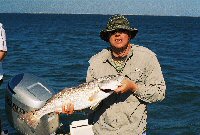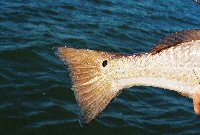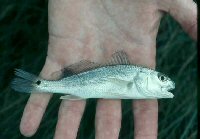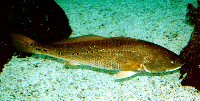Red Drum - An Angler's Delight
Kyle Spiller, Ecosystem Leader, Upper Laguna Madre, Coastal Fisheries Division
Rarely has a single fish so strongly captured the imagination, dedication and admiration of so many anglers as the red drum. Revered for its power, speed and delectable flavor, red drum have become one of the most popular game fish in Texas marine waters.

Many old salts will remember in the late 1970’s and early 1980’s when red drum all but disappeared from our bays. Management measures were adopted in the late 1980’s which included banning commercial netting, implementation of bag and size limits, and the designation of red drum as a game fish. In addition to implementing these traditional management measures, Coastal Fisheries began a stocking program to enhance the wild population of red drum. The first red drum fingerings were stocked in 1983 and about 30 million are stocked in Texas bays each year. While stocking red drum to enhance the wild population had not been done before, it has proven to be a successful and important part of our management program. Thanks to these management measures and research into the mysteries of red drum life history, the fishery has recovered to arguably one of the best in the nation, and represents one of the Texas Parks and Wildlife Department – Coastal Fisheries' greatest success stories.
Red drum can be found from the Gulf of Maine to Tuxpan, Mexico and belong to the drum family with close relatives that include Atlantic croaker, spotted seatrout and black drum. Red drum range in color from copper to nearly silver, but the most common color is reddish-bronze. The most distinguishing mark on a red drum is the single large black spot on the upper part of the base of their tail. Having multiple spots is not uncommon while having no spots is relatively rare.

Red drum are estuarine dependent -- that is they spend at least part of their life in the bays. Life for a red drum begins as an egg spawned during late summer and fall, usually from August into November. Adults gather in near-shore waters on the Gulf side of barrier islands near passes and channels to spawn. Each female can produce from 20,000 to 200,000 eggs per spawn and can spawn over a dozen times during a season. Females broadcast their eggs into the current where they are fertilized by the male and start their life cycle.

After hatching, the larvae are carried by tidal currents into the shallow waters of bays and estuaries. As the larvae enter these waters, they seek quiet grassy areas where they are protected from both predators and currents that could carry them off-shore. The larvae remain in these areas, feeding on small invertebrates and zooplankton until they are about an inch long -- usually a few weeks. Red drum ranging from an inch to 30 inches are considered juveniles.
As juvenile red drum grow and mature, they disperse through the bay system and are found in a wide variety of habitats. They grow rapidly reaching 12 inches (3/4 pound) by the end of their first year and 22 inches (4.1 pounds) by the time they are two years old. While they prefer shallow protected open waters of bays and estuaries, they are occasionally found in the surf along Gulf beaches. They remain in these areas feeding on small fish, shrimp and crabs until they are three or four years old and about 30 inches long.

Red drum more than four years old and 30 inches long have reached maturity. These adults spend more time in Gulf waters, only occasionally being found in the shallow waters of bay and estuaries. Food preferences of adults vary little from juvenile red drum, except adults tend to feed on larger fish, shrimp and crabs. Today, the average size of the 225,000 red drum landed by Texas anglers each year is 23 inches and weighs about 4.7 pounds. However, adults can live for more than 40 years, be five feet long and tip the scale at more than 80 pounds. The current state record red drum was caught in the Gulf of Mexico in January 2000 and was 54 ¼ inches long and 59 ½ pounds. The world record red drum weighed just over 94 pounds and was caught in North Carolina in November 1984.
With continued good management, stocking and research, many generations of Texas anglers will be able to enjoy the red drum fishing experience. Where casting to a school of tailing fish can result in those long powerful runs that cramp your hands and cause your arms and shoulders to burn while you are thinking, “It doesn’t get any better than this”.
© Copyright Texas Parks and Wildlife Department. No part of this work may be copied, reproduced, or translated in any form or medium without the prior written consent of Texas Parks Wildlife Department except where specifically noted. If you want to use these articles, see Site Policies